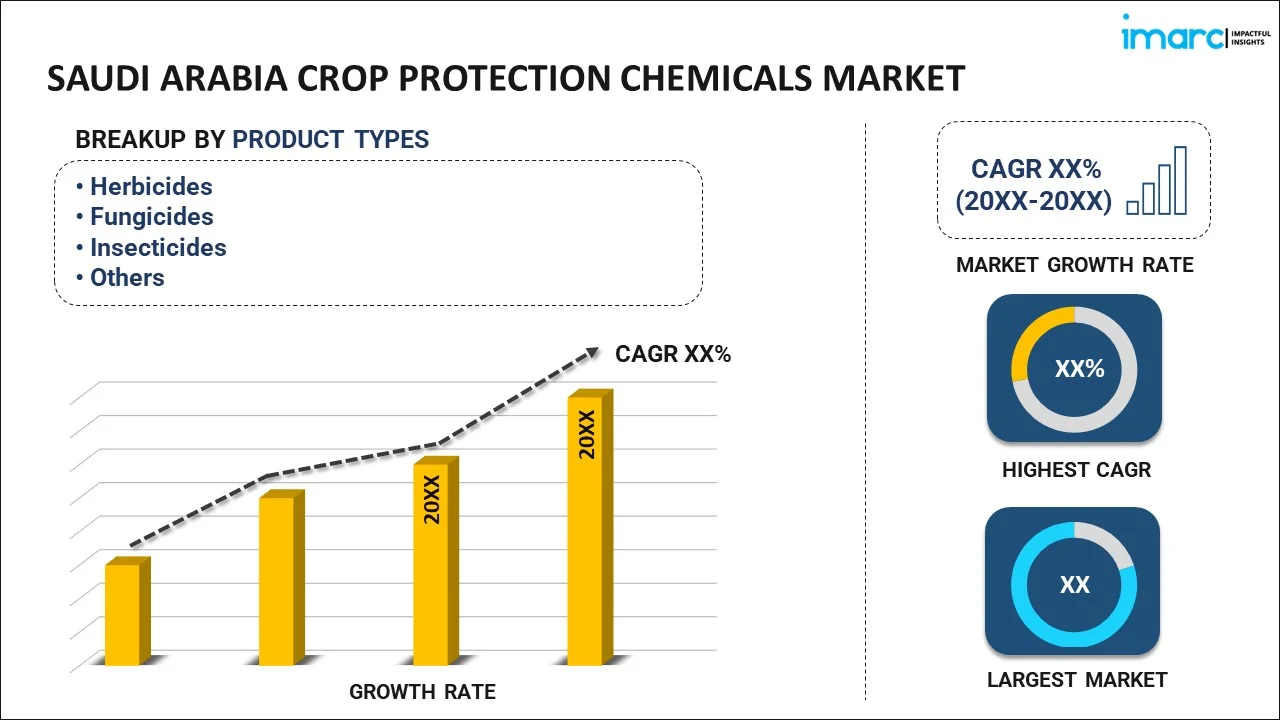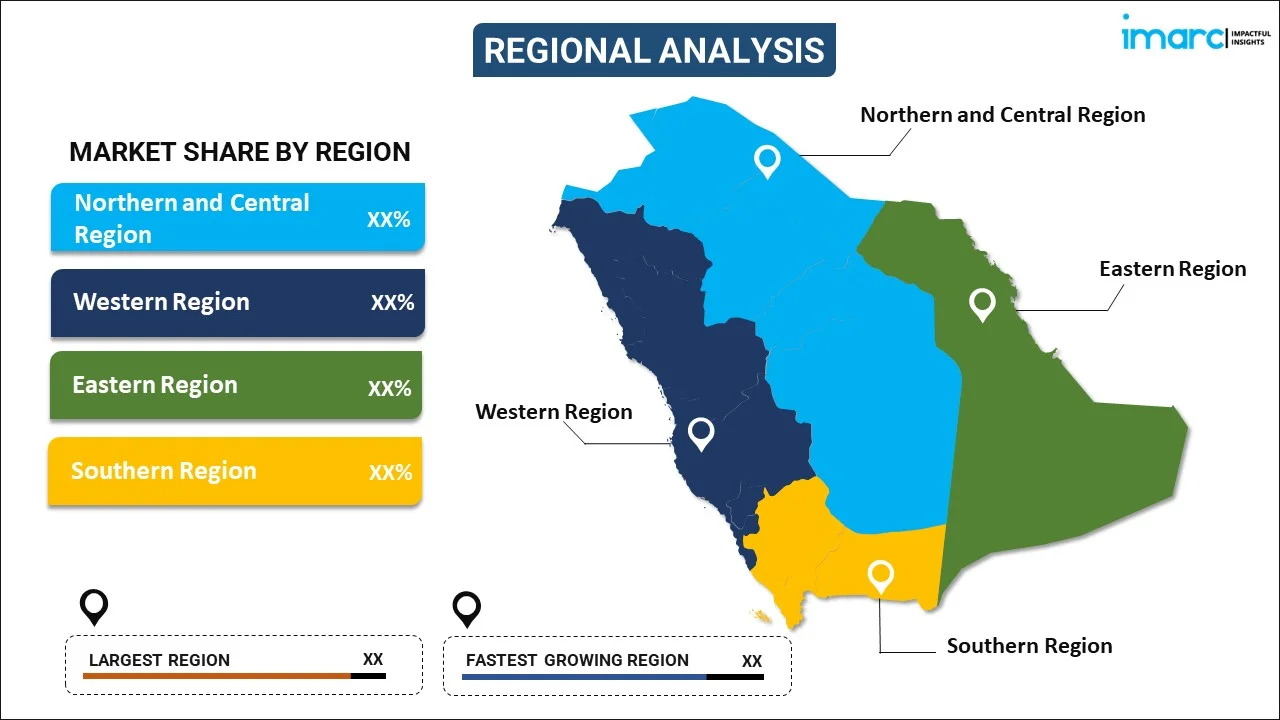
Saudi Arabia Crop Protection Chemicals Market Report by Product Type (Herbicides, Fungicides, Insecticides, and Others), Origin (Synthetic, Natural), Crop Type (Cereal and Grains, Fruits and Vegetables, Oilseed and Pulses, and Others), Form (Liquid, Solid), Mode of Application (Foliar Spray, Seed Treatment, Soil Treatment, and Others), and Region 2024-2032
Market Overview:
The Saudi Arabia crop protection chemicals market size is projected to exhibit a growth rate (CAGR) of 4.30% during 2024-2032. The adoption of advanced farming technologies and practices, the rising government support through subsidies, research and development initiatives, and regulatory frameworks, and the increasing awareness among farmers about the benefits of crop protection chemicals represent some of the key factors driving the market.
|
Report Attribute
|
Key Statistics
|
|---|---|
|
Base Year
|
2023 |
|
Forecast Years
|
2024-2032
|
|
Historical Years
|
2018-2023
|
| Market Growth Rate (2024-2032) | 4.30% |
Crop protection chemicals, often referred to as pesticides or agrochemicals, are chemical substances used in agriculture to protect crops from pests, diseases, weeds, and other factors that can reduce crop yields and quality. These chemicals play a crucial role in modern agriculture by helping farmers manage and safeguard their crops effectively. By controlling pests, diseases, and weeds, these chemicals help farmers maximize crop yields and ensure a consistent and abundant food supply. They also contribute to improving the quality of harvested crops by preventing damage and disease. This, in turn, enhances the marketability of agricultural products. Besides, when used judiciously and following best practices, these chemicals can contribute to sustainable agriculture by reducing the need for additional land and resources to compensate for crop losses. Crop protection chemicals are an essential part of modern agriculture, helping farmers mitigate the risks posed by pests and diseases, improve crop yields, and ensure food production.
Saudi Arabia Crop Protection Chemicals Market Trends:
Saudi Arabia has been investing in expanding its agricultural sector, including greenhouse and precision farming. The increase in cultivated land and the diversity of crops being grown create a demand for crop protection chemicals to ensure the health and yield of these crops. In addition, the adoption of advanced farming technologies and practices in Saudi Arabia has led to increased awareness of the benefits of crop protection chemicals. Farmers are more inclined to use these chemicals to optimize their crop production. Besides, water scarcity is a prevalent issue in Saudi Arabia. The use of crop protection chemicals can help maximize water efficiency by reducing crop losses due to pests and diseases, making it a critical factor for water-efficient agriculture. Moreover, the Saudi Arabian government supports the agricultural sector through subsidies, research and development initiatives, and regulatory frameworks. This support encourages farmers to invest in crop protection chemicals for better agricultural outcomes. Additionally, the country's agricultural sector is exploring opportunities for crop exports. To meet international quality standards and gain access to global markets, the use of crop protection chemicals is essential to produce high-quality crops. Furthermore, the increasing awareness among farmers about the benefits of crop protection chemicals and their proper use is driving adoption. Training and educational programs play a role in disseminating knowledge on best practices. Apart from this, the implementation of IPM practices, which combine various pest control methods, including the judicious use of crop protection chemicals, is gaining traction as a sustainable approach to pest management.
Saudi Arabia Crop Protection Chemicals Market Segmentation:
IMARC Group provides an analysis of the key trends in each segment of the market, along with forecasts at the country levels for 2024-2032. Our report has categorized the market based on product type, origin, crop type, form, and mode of application.
Product Type Insights:

- Herbicides
- Fungicides
- Insecticides
- Others
The report has provided a detailed breakup and analysis of the market based on the product type. This includes herbicides, fungicides, insecticides, and others.
Origin Insights:
- Synthetic
- Natural
A detailed breakup and analysis of the market based on the origin have also been provided in the report. This includes synthetic and natural.
Crop Type Insights:
- Cereal and Grains
- Fruits and Vegetables
- Oilseed and Pulses
- Others
The report has provided a detailed breakup and analysis of the market based on the crop type. This includes cereal and grains, fruits and vegetables, oilseed and pulses, and others.
Form Insights:
- Liquid
- Solid
A detailed breakup and analysis of the market based on the form have also been provided in the report. This includes liquid and solid.
Mode of Application Insights:
- Foliar Spray
- Seed Treatment
- Soil Treatment
- Others
The report has provided a detailed breakup and analysis of the market based on the mode of application. This includes foliar spray, seed treatment, soil treatment, and others.
Regional Insights:

- Northern and Central Region
- Western Region
- Eastern Region
- Southern Region
The report has also provided a comprehensive analysis of all the major regional markets, which include Northern and Central Region, Western Region, Eastern Region, and Southern Region.
Competitive Landscape:
The market research report has also provided a comprehensive analysis of the competitive landscape. Competitive analysis such as market structure, key player positioning, top winning strategies, competitive dashboard, and company evaluation quadrant has been covered in the report. Also, detailed profiles of all major companies have been provided. Some of the key players include:
- Astra Agricultural Co. Ltd.
- Bayer AG
- Saudi Basic Industries Corporation (SABIC) (Aramco Chemicals Company)
- Saudi Delta Company Inc.
(Please note that this is only a partial list of the key players, and the complete list is provided in the report.)
Saudi Arabia Crop Protection Chemicals Market Report Coverage:
| Report Features | Details |
|---|---|
| Base Year of the Analysis | 2023 |
| Historical Period | 2018-2023 |
| Forecast Period | 2024-2032 |
| Units | US$ Million |
| Scope of the Report | Exploration of Historical and Forecast Trends, Industry Catalysts and Challenges, Segment-Wise Historical and Predictive Market Assessment:
|
| Product Types Covered | Herbicides, Fungicides, Insecticides, Others |
| Origins Covered | Synthetic, Natural |
| Crop Types Covered | Cereal and Grains, Fruits and Vegetables, Oilseed and Pulses, Others |
| Forms Covered | Liquid, Solid |
| Mode of Applications Covered | Foliar Spray, Seed Treatment, Soil Treatment, Others |
| Regions Covered | Northern and Central Region, Western Region, Eastern Region, Southern Region |
| Companies Covered | Astra Agricultural Co. Ltd., Bayer AG, Saudi Basic Industries Corporation (SABIC) (Aramco Chemicals Company), Saudi Delta Company Inc., etc. (Please note that this is only a partial list of the key players, and the complete list is provided in the report.) |
| Customization Scope | 10% Free Customization |
| Report Price and Purchase Option | Single User License: US$ 3699 Five User License: US$ 4699 Corporate License: US$ 5699 |
| Post-Sale Analyst Support | 10-12 Weeks |
| Delivery Format | PDF and Excel through Email (We can also provide the editable version of the report in PPT/Word format on special request) |
Key Questions Answered in This Report:
- How has the Saudi Arabia crop protection chemicals market performed so far and how will it perform in the coming years?
- What has been the impact of COVID-19 on the Saudi Arabia crop protection chemicals market?
- What is the breakup of the Saudi Arabia crop protection chemicals market on the basis of product type?
- What is the breakup of the Saudi Arabia crop protection chemicals market on the basis of origin?
- What is the breakup of the Saudi Arabia crop protection chemicals market on the basis of crop type?
- What is the breakup of the Saudi Arabia crop protection chemicals market on the basis of form?
- What is the breakup of the Saudi Arabia crop protection chemicals market on the basis of mode of application?
- What are the various stages in the value chain of the Saudi Arabia crop protection chemicals market?
- What are the key driving factors and challenges in the Saudi Arabia crop protection chemicals?
- What is the structure of the Saudi Arabia crop protection chemicals market and who are the key players?
- What is the degree of competition in the Saudi Arabia crop protection chemicals market?
Key Benefits for Stakeholders:
- IMARC’s industry report offers a comprehensive quantitative analysis of various market segments, historical and current market trends, market forecasts, and dynamics of the Saudi Arabia crop protection chemicals market from 2018-2032.
- The research report provides the latest information on the market drivers, challenges, and opportunities in the Saudi Arabia crop protection chemicals market.
- Porter's five forces analysis assist stakeholders in assessing the impact of new entrants, competitive rivalry, supplier power, buyer power, and the threat of substitution. It helps stakeholders to analyze the level of competition within the Saudi Arabia crop protection chemicals industry and its attractiveness.
- Competitive landscape allows stakeholders to understand their competitive environment and provides an insight into the current positions of key players in the market.
Need more help?
- Speak to our experienced analysts for insights on the current market scenarios.
- Include additional segments and countries to customize the report as per your requirement.
- Gain an unparalleled competitive advantage in your domain by understanding how to utilize the report and positively impacting your operations and revenue.
- For further assistance, please connect with our analysts.
 Inquire Before Buying
Inquire Before Buying
 Speak to an Analyst
Speak to an Analyst
 Request Brochure
Request Brochure
 Request Customization
Request Customization




.webp)




.webp)












